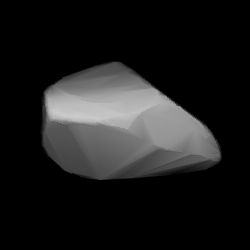 Modelled shape of Yvonne from its lightcurve | |
| Discovery [1] | |
|---|---|
| Discovered by | L. Boyer |
| Discovery site | Algiers Obs. |
| Discovery date | 7 March 1934 |
| Designations | |
| (1301) Yvonne | |
Named after | Yvonne Boyer [2] (discoverer's sister) |
| 1934 EA | |
| main-belt ·(outer) [3] background [4] | |
| Orbital characteristics [1] | |
| Epoch 4 September 2017 (JD 2458000.5) | |
| Uncertainty parameter 0 | |
| Observation arc | 83.32 yr (30,433 days) |
| Aphelion | 3.5134 AU |
| Perihelion | 2.0225 AU |
| 2.7680 AU | |
| Eccentricity | 0.2693 |
| 4.61 yr (1,682 days) | |
| 96.456° | |
| 0° 12m 50.4s / day | |
| Inclination | 34.030° |
| 161.56° | |
| 302.27° | |
| Physical characteristics | |
| 18.693±4.943 km [5] 20.44±5.24 km [6] 21.438±0.088 km [7] 21.54±0.25 km [8] 21.681±0.204 km [9] 21.95±0.41 km [10] 22.77±2.4 km [11] | |
| 7.2536±0.0002 h [12] 7.3196±0.0001 h [12] 7.3200±0.0001 h [13] 7.320±0.005 h [14] | |
Pole ecliptic latitude | (39.0°, 41.0°) (λ1/β1) [15] |
| 0.10±0.12 [6] 0.111±0.020 [10] 0.1167±0.0700 [5] 0.1632±0.040 [11] 0.1806±0.0479 [9] 0.201±0.006 [8] | |
| SMASS = C [1] [3] · C [16] | |
| 10.80 [8] [9] [11] ·11.30 [1] [3] [5] [10] ·11.32 [6] ·11.40±0.22 [16] | |
1301 Yvonne (prov. designation: 1934 EA) is a carbonaceous background asteroid from the background population of the intermediate asteroid belt, approximately 21 kilometers (13 miles) in diameter. It was discovered on 7 March 1934, by French astronomer Louis Boyer at the Algiers Observatory in North Africa. [17] The asteroid was named for the discoverer's sister, Yvonne Boyer
